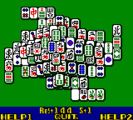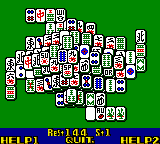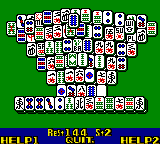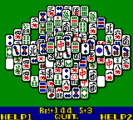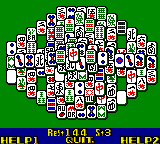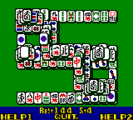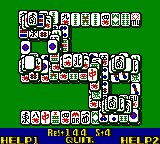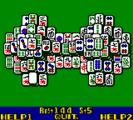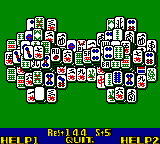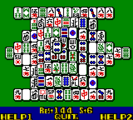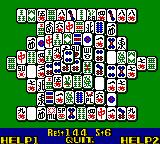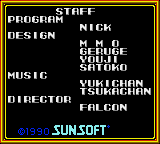Difference between revisions of "Shanghai II"
From Sega Retro
SEGAAA2004 (talk | contribs) |
|||
| (12 intermediate revisions by 8 users not shown) | |||
| Line 1: | Line 1: | ||
| + | {{otherPage|desc=the [[Sega Mega Drive]] game|page=Shanghai II: Dragon's Eye}} | ||
{{Bob | {{Bob | ||
| bobscreen=ShanghaiII GG title.png | | bobscreen=ShanghaiII GG title.png | ||
| + | | licensor= [[Activision]] | ||
| publisher=[[Sunsoft]] | | publisher=[[Sunsoft]] | ||
| − | | developer=[[ | + | | developer=[[Falcon]]{{ref|https://gdri.smspower.org/wiki/index.php/Falcon}} |
| system=[[Sega Game Gear]] | | system=[[Sega Game Gear]] | ||
| sounddriver= | | sounddriver= | ||
| peripherals=[[Gear-to-Gear Cable]] | | peripherals=[[Gear-to-Gear Cable]] | ||
| players=1-2 | | players=1-2 | ||
| − | | genre= | + | | genre=Puzzle{{fileref|ShanghaiII GG JP Box Front.jpg}}{{ref|https://web.archive.org/web/20130101202427/http://sega.jp/fb/segahard/gg/soft_licensee.html}} |
| releases={{releasesGG | | releases={{releasesGG | ||
| − | | gg_date_jp=1990-12-27 | + | | gg_date_jp=1990-12-27{{ref|https://web.archive.org/web/20130101202427/http://sega.jp/fb/segahard/gg/soft_licensee.html}} |
| gg_code_jp=T-15017 | | gg_code_jp=T-15017 | ||
| gg_rrp_jp=3,800 | | gg_rrp_jp=3,800 | ||
| Line 17: | Line 19: | ||
}} | }} | ||
}} | }} | ||
| − | + | '''''{{PAGENAME}}''''' (上海II) is a mahjong solitaire game for the [[Sega Game Gear]]. | |
| + | |||
| + | It is not to be confused with ''[[Shanghai II: Dragon's Eye]]'' on the [[Sega Mega Drive]]. Both games are sequels to ''[[Shanghai]]''. | ||
| + | |||
| + | ==Gameplay== | ||
| + | The game is a matching game using mahjong tiles, like its predecessor. There are 144 mahjong tiles stacked in a pattern on the board, and players must remove all of the tiles two at a time by matching them with each other. Tiles can only be selected if they do not have another tile on top of them and no tiles touching either their left or right side. Two tiles can be matched if they have if they have identical symbols on top of them. Any two flower, dragon, or season tiles can be matched with each other as well. There is some strategy involved in choosing which tiles to remove in such a way to expose other potential matches. The game is won when all pairs of tiles have been removed from the board or lost if the remaining tiles contain no exposed pairs. | ||
| + | |||
| + | The game uses a cursor, which is moved using the D-Pad. The player can select a tile with {{1}} or cancel a selection with {{2}}. Tiles can only be selected if they have no other tiles on top of them and a free space to either side of them. When one tile has been selected, a second tile can only be selected if it is a valid match. Pressing {{1}} again when two tiles are selected confirms the match and removes the tiles. | ||
| + | |||
| + | In single-player games, there are two menus at the top of the screen that can be selected by the cursor: Help1 and Help2. The Help1 menu contains items to show possible moves (Find) or undo the last move (Back). The Help2 menu contains items to reveal covered tiles by removing the tiles on top of them (Peek), restart the current game (Retry), or start a new game with the same tiles (New). All of the items in the Help2 menu necessitate ending the current game. In multiplayer games, there is only one menu, Help, which shows a possible move when used. This can only be used three times per game. | ||
| + | |||
| + | ===Modes=== | ||
| + | There are three game modes: | ||
| + | *'''Solitaire:''' A single-player mode. There are six different formations to choose (which determine the shape of the arrangement of tiles). The symbols on the tiles are randomized for every game. | ||
| + | *'''Tournament:''' A mode for multiple players to compete, where each player takes turns playing a game, sharing the same Game Gear. Each game has a time limit of 30 seconds. After the game, players are returned to a menu where they can view the best scores, continue the tournament, or start a new game (with new scores). | ||
| + | *'''Challenge:''' A two-player mode, where each player takes turns making a move on the same board, using separate Game Gears linked over a [[Gear-to-Gear Cable]]. Players have a time limit for each turn and compete to have the best score. | ||
| + | |||
| + | There is a settings menu that allows the player to choose between three music tracks, change the difficulty level (Easy or Normal), and change the tile symbols (Japanese or European). | ||
| + | |||
| + | ===Formations=== | ||
| + | {{gallery|widths=160|screens=yes| | ||
| + | {{gitem|Shanghai II GG, Formations, Tiger.png|Tiger}} | ||
| + | {{gitem|Shanghai II GG, Formations, Scorpion.png|Scorpion}} | ||
| + | {{gitem|Shanghai II GG, Formations, Monkey.png|Monkey}} | ||
| + | {{gitem|Shanghai II GG, Formations, Snake.png|Snake}} | ||
| + | {{gitem|Shanghai II GG, Formations, Panther.png|Panther}} | ||
| + | {{gitem|Shanghai II GG, Formations, Dragon.png|Dragon}} | ||
| + | }} | ||
| + | |||
| + | ==Production credits== | ||
| + | {{creditstable| | ||
| + | *'''Program:''' Nick | ||
| + | *'''Design:''' M M O, Geruge, Youji, Satoko | ||
| + | *'''Music:''' Yukichan, Tsukachan | ||
| + | *'''Director:''' [[Falcon]] | ||
| + | | source=In-game credits | ||
| + | | pdf=Shanghai II GG credits.png | ||
| + | | console=GG | ||
| + | }} | ||
==Magazine articles== | ==Magazine articles== | ||
| Line 23: | Line 63: | ||
==Physical scans== | ==Physical scans== | ||
| + | {{ratings|GG}} | ||
{{Scanbox | {{Scanbox | ||
| console=Game Gear | | console=Game Gear | ||
| Line 34: | Line 75: | ||
| console=Game Gear | | console=Game Gear | ||
| region=JP ([[Meisaku Collection]]) | | region=JP ([[Meisaku Collection]]) | ||
| − | | front= | + | | front=ShanghaiII GG JP Box Front Meisaku.jpg |
| − | | back= | + | | back=ShanghaiII GG JP Box Back Meisaku.jpg |
| − | | spine= | + | | spine=ShanghaiII GG JP Spine Meisaku.jpg |
| − | | spine2= | + | | spine2=ShanghaiII GG JP Spine2 Meisaku.jpg |
| square=yes | | square=yes | ||
| − | | cart= | + | | cart=ShanghaiII GG JP Cart Meisaku.jpg |
| − | | cartback= | + | | cartback=ShanghaiII GG JP Cart Back Meisaku.jpg |
}} | }} | ||
| Line 46: | Line 87: | ||
===ROM dump status=== | ===ROM dump status=== | ||
{{romtable| | {{romtable| | ||
| − | {{rom|GG|sha1=5180891EC0AE08D784DD89222D9FFD7F88A59691|md5=A9D1712DCA313BA021844F62EEC8A08C|crc32=2AE8C75F|size= | + | {{rom|GG|sha1=5180891EC0AE08D784DD89222D9FFD7F88A59691|md5=A9D1712DCA313BA021844F62EEC8A08C|crc32=2AE8C75F|size=128KB|date=|source=Cartridge (JP)|comments=|quality=good|prototype=}} |
| − | {{rom|GG|sha1=82210B387344AAEBAE8CF03029967CD0C906BEFF|md5=C228D31CF77BD03AC457E2D22F5B2BD1|crc32=81314249|size= | + | {{rom|GG|sha1=82210B387344AAEBAE8CF03029967CD0C906BEFF|md5=C228D31CF77BD03AC457E2D22F5B2BD1|crc32=81314249|size=128KB|date=|source=Cartridge (JP)|comments=(Rev A)|quality=good|prototype=}} |
}} | }} | ||
==References== | ==References== | ||
| + | {{NECRetro|italics=yes}} | ||
<references/> | <references/> | ||
| − | |||
| + | {{ShanghaiIIOmni}} | ||
{{Shanghai}} | {{Shanghai}} | ||
Latest revision as of 13:54, 20 February 2024
- For the Sega Mega Drive game, see Shanghai II: Dragon's Eye.
| Shanghai II | |||||||||||||||
|---|---|---|---|---|---|---|---|---|---|---|---|---|---|---|---|
| System(s): Sega Game Gear | |||||||||||||||
| Publisher: Sunsoft | |||||||||||||||
| Developer: Falcon[1] | |||||||||||||||
| Licensor: Activision | |||||||||||||||
| Peripherals supported: Gear-to-Gear Cable | |||||||||||||||
| Genre: Puzzle[2][3] | |||||||||||||||
| Number of players: 1-2 | |||||||||||||||
|
Shanghai II (上海II) is a mahjong solitaire game for the Sega Game Gear.
It is not to be confused with Shanghai II: Dragon's Eye on the Sega Mega Drive. Both games are sequels to Shanghai.
Contents
Gameplay
The game is a matching game using mahjong tiles, like its predecessor. There are 144 mahjong tiles stacked in a pattern on the board, and players must remove all of the tiles two at a time by matching them with each other. Tiles can only be selected if they do not have another tile on top of them and no tiles touching either their left or right side. Two tiles can be matched if they have if they have identical symbols on top of them. Any two flower, dragon, or season tiles can be matched with each other as well. There is some strategy involved in choosing which tiles to remove in such a way to expose other potential matches. The game is won when all pairs of tiles have been removed from the board or lost if the remaining tiles contain no exposed pairs.
The game uses a cursor, which is moved using the D-Pad. The player can select a tile with ![]() or cancel a selection with
or cancel a selection with ![]() . Tiles can only be selected if they have no other tiles on top of them and a free space to either side of them. When one tile has been selected, a second tile can only be selected if it is a valid match. Pressing
. Tiles can only be selected if they have no other tiles on top of them and a free space to either side of them. When one tile has been selected, a second tile can only be selected if it is a valid match. Pressing ![]() again when two tiles are selected confirms the match and removes the tiles.
again when two tiles are selected confirms the match and removes the tiles.
In single-player games, there are two menus at the top of the screen that can be selected by the cursor: Help1 and Help2. The Help1 menu contains items to show possible moves (Find) or undo the last move (Back). The Help2 menu contains items to reveal covered tiles by removing the tiles on top of them (Peek), restart the current game (Retry), or start a new game with the same tiles (New). All of the items in the Help2 menu necessitate ending the current game. In multiplayer games, there is only one menu, Help, which shows a possible move when used. This can only be used three times per game.
Modes
There are three game modes:
- Solitaire: A single-player mode. There are six different formations to choose (which determine the shape of the arrangement of tiles). The symbols on the tiles are randomized for every game.
- Tournament: A mode for multiple players to compete, where each player takes turns playing a game, sharing the same Game Gear. Each game has a time limit of 30 seconds. After the game, players are returned to a menu where they can view the best scores, continue the tournament, or start a new game (with new scores).
- Challenge: A two-player mode, where each player takes turns making a move on the same board, using separate Game Gears linked over a Gear-to-Gear Cable. Players have a time limit for each turn and compete to have the best score.
There is a settings menu that allows the player to choose between three music tracks, change the difficulty level (Easy or Normal), and change the tile symbols (Japanese or European).
Formations
Production credits
- Program: Nick
- Design: M M O, Geruge, Youji, Satoko
- Music: Yukichan, Tsukachan
- Director: Falcon
Magazine articles
- Main article: Shanghai II/Magazine articles.
Physical scans
| Sega Retro Average | ||||||||||||||||||||||||||||||||||
|---|---|---|---|---|---|---|---|---|---|---|---|---|---|---|---|---|---|---|---|---|---|---|---|---|---|---|---|---|---|---|---|---|---|---|
|
| 69 | |
|---|---|
| Based on 6 reviews | |
| Game Gear, JP (Meisaku Collection) |
|---|
Technical information
ROM dump status
| System | Hash | Size | Build Date | Source | Comments | |||||||||
|---|---|---|---|---|---|---|---|---|---|---|---|---|---|---|
| ✔ |
|
128kB | Cartridge (JP) | |||||||||||
| ✔ |
|
128kB | Cartridge (JP) | (Rev A) |
References
NEC Retro has more information related to Shanghai II
|
- ↑ https://gdri.smspower.org/wiki/index.php/Falcon
- ↑ File:ShanghaiII GG JP Box Front.jpg
- ↑ 3.0 3.1 http://sega.jp/fb/segahard/gg/soft_licensee.html (Wayback Machine: 2013-01-01 20:24)
- ↑ File:Shanghai II GG credits.png
- ↑ Aktueller Software Markt, "August/September 1991" (DE; 1991-07-26), page 124
- ↑ Beep! MegaDrive, "February 1991" (JP; 1991-01-08), page 85
- ↑ Game Power, "Luigio/Agosto 1992" (IT; 1992-0x-xx), page 73
- ↑ Hippon Super, "February 1991" (JP; 1991-01-07), page 43
- ↑ Joystick, "Mars 1991" (FR; 1991-0x-xx), page 127
- ↑ Sega Saturn Magazine, "September 1995" (JP; 1995-08-08), page 88
| Shanghai II | |
|---|---|
|
Main page | Magazine articles | Reception | |
| Shanghai games for Sega systems | |
|---|---|
| Shanghai (1988) | |
| Shanghai II (1990) | |
| Dragon's Eye Plus: Shanghai III (1991) | Shanghai II: Dragon's Eye (1994) | |
| Shanghai: Triple-Threat (1995) | Game no Tetsujin The Shanghai (1995) | Shanghai Great Moments (1996) | |
| Shanghai Dynasty (2000) | |
| Super Shanghai 2005 (2005) | |

